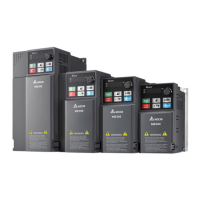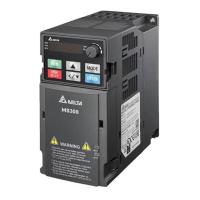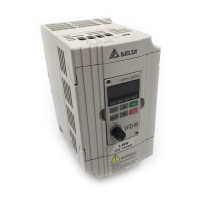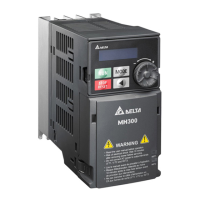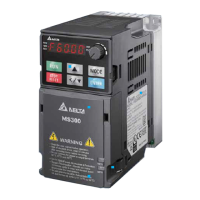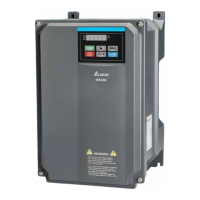Chapter 12 Description of Parameter SettingsME300
.
Torque Compensation Gain (Motor 2)
Default: 1
Settings
IM: 0–10 (when Pr.05-33 = 0)
PM: 0–5000 (when Pr.05-33 = 1 or 2)
IMV/F and PMSVC Control Mode only.
With a large motor load, a part of drive output voltage is absorbed by the stator winding resistor;
therefore, the air gap magnetic field is insufficient. This causes insufficient voltage at motor
induction and results in excessive output current but insufficient output torque. Auto-torque
compensation can automatically adjust the output voltage according to the load and keep the air
gap magnetic fields stable to get the optimal operation.
In the V/F control, the voltage decreases in direct proportion with decreasing frequency. It reduces
the torque decrease at low speed due to the AC while the DC resistor is unchanged. The auto-
torque compensation function increases the output voltage at low frequency to get a higher
starting torque.
When the compensation gain is set too high, it may cause motor over-flux and result in a too large
output current, overheating the motor or triggering the protection function.
This parameter affects the output current during operation. The low-speed zone has less impact.
When the compensation gain is set too large, it may cause motor over-flux and result in a too
large output current of the drive, motor overheating or trigger the drive’s protection function.
Slip Compensation Gain (Motor 2)
Default: 0.00
Settings
0.00–10.00 (Default value is 1 in SVC mode)
IMSVC Control Mode only.
The induction motor needs constant slip to produce magnetic torque. It can be ignored at higher
motor speeds, such as rated speed or 2–3% of slip.
In operation, the slip and the synchronous frequency are in reverse proportion to produce the
same magnetic torque. The slip is larger with the reduction of the synchronous frequency. The
motor may stop when the synchronous frequency decreases to a specific value. Therefore, the
slip seriously affects the motor speed accuracy at low speed.
In another situation, when you use an induction motor with the drive, the slip increases when the
load increases. It also affects the motor speed accuracy.
Use this parameter to set the compensation frequency, and reduce the slip to maintain the
synchronous speed when the motor runs at the rated current in order to improve the accuracy of
the drive. When the drive output current is higher than Pr.05-05 (No-load Current of Induction
Motor 1 (A)), the drive compensates the frequency with this parameter.
This parameter is set to 1.00 automatically when Pr.00-11 (Speed Control Method) is changed
from V/F mode to vector mode. Apply the slip compensation after load and acceleration. Increase
the compensation value from small to large gradually; add the output frequency with motor rated
slip
× Pr.07-27 (Slip Compensation Gain) when the motor is at the rated load. If the actual speed

